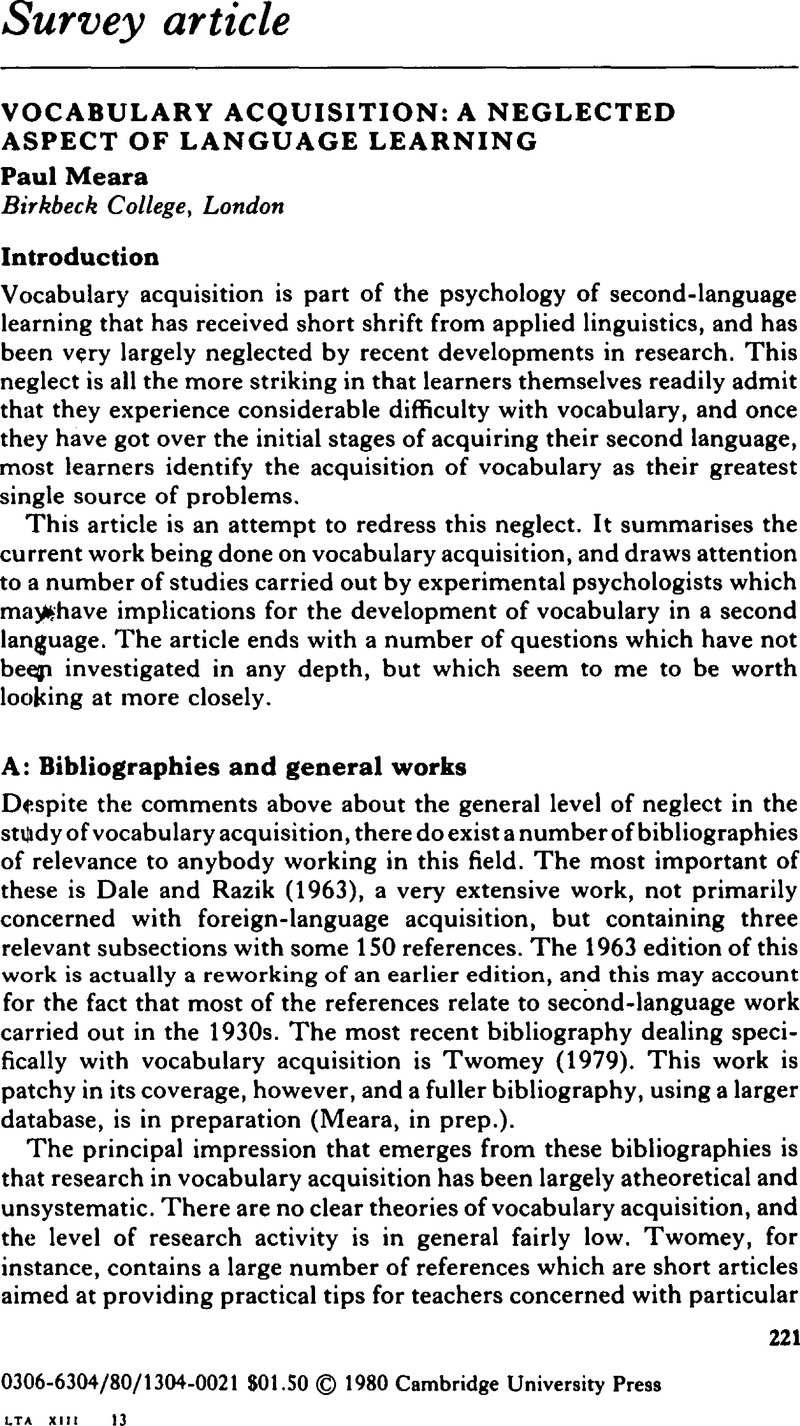Crossref Citations
This article has been cited by the following publications. This list is generated based on data provided by Crossref.
Rivers, Wilga M.
1981.
APPLES OF GOLD IN PICTURES OF SILVER: WHERE HAVE ALL THE WORDS GONE?.
Studia Linguistica,
Vol. 35,
Issue. 1-2,
p.
114.
Cohen, Andrew D.
1987.
The Use of Verbal and Imagery Mnemonics in Second-Language Vocabulary Learning.
Studies in Second Language Acquisition,
Vol. 9,
Issue. 1,
p.
43.
Palmberg, Rolf
1987.
Patterns of Vocabulary Development in Foreign-Language Learners.
Studies in Second Language Acquisition,
Vol. 9,
Issue. 2,
p.
201.
LAUFER, BATIA
1991.
The Development of L2 Lexis in the Expression of the Advanced Learner.
The Modern Language Journal,
Vol. 75,
Issue. 4,
p.
440.
Clarke, Michael
1992.
VOCABULARY LEARNING WITH AND WITHOUT COMPUTERS SOME THOUGHTS ON A WAY FORWARD.
Computer Assisted Language Learning,
Vol. 5,
Issue. 3,
p.
139.
Kang, Hee‐Won
and
Golden, Anne
1994.
Vocabulary learning and instruction in a second or foreign language.
International Journal of Applied Linguistics,
Vol. 4,
Issue. 1,
p.
57.
Ellis, Rod
Tanaka, Yoshihiro
and
Yamazaki, Asako
1994.
Classroom Interaction, Comprehension, and the Acquisition of L2 Word Meanings.
Language Learning,
Vol. 44,
Issue. 3,
p.
449.
Singleton, David
1994.
Introduction : le rôle de la forme et du sens dans le lexique mental en l2.
Acquisition et interaction en langue étrangère,
p.
3.
SANAOUI, RAZIKA
1995.
Adult Learners' Approaches to Learning Vocabulary in Second Languages.
The Modern Language Journal,
Vol. 79,
Issue. 1,
p.
15.
Ellis, Nick C.
1995.
THE PSYCHOLOGY OF FOREIGN LANGUAGE VOCABULARY ACQUISITION: IMPLICATIONS FOR CALL.
Computer Assisted Language Learning,
Vol. 8,
Issue. 2-3,
p.
103.
Kang, Sook-Hi
1995.
The effects of a context-embedded approach to second-language vocabulary learning.
System,
Vol. 23,
Issue. 1,
p.
43.
Gu, Yongqi
and
Johnson, Robert Keith
1996.
Vocabulary Learning Strategies and Language Learning Outcomes.
Language Learning,
Vol. 46,
Issue. 4,
p.
643.
Griffin, Gerry
and
Harley, Trevor A.
1996.
List learning of second language vocabulary.
Applied Psycholinguistics,
Vol. 17,
Issue. 4,
p.
443.
Korte, Barbara
Müller, Klaus Peter
and
Schmied, Josef
1997.
Einführung in die Anglistik.
p.
283.
1998.
Book and Software Reviews / Critiques de livres et de logiciels.
The Canadian Modern Language Review,
Vol. 54,
Issue. 4,
p.
586.
Schmitt, N
1998.
Quantifying word association responses: what is native-like?.
System,
Vol. 26,
Issue. 3,
p.
389.
Boulton, Alex
2000.
From oxidation to Paf the Dog: mental images of student engineers in EFL vocabulary association and retention.
ASp,
p.
33.
Holzman, Susan
2000.
Dictioiwries.
TESOL Journal,
Vol. 9,
Issue. 1,
p.
40.
Kecskés, Istvan
2000.
A cognitive-pragmatic approach to situation-bound utterances.
Journal of Pragmatics,
Vol. 32,
Issue. 5,
p.
605.
Zahar, Rick
Cobb, Tom
and
Spada, Nina
2001.
Acquiring Vocabulary through Reading: Effects of Frequency and Contextual Richness.
The Canadian Modern Language Review,
Vol. 57,
Issue. 4,
p.
541.





